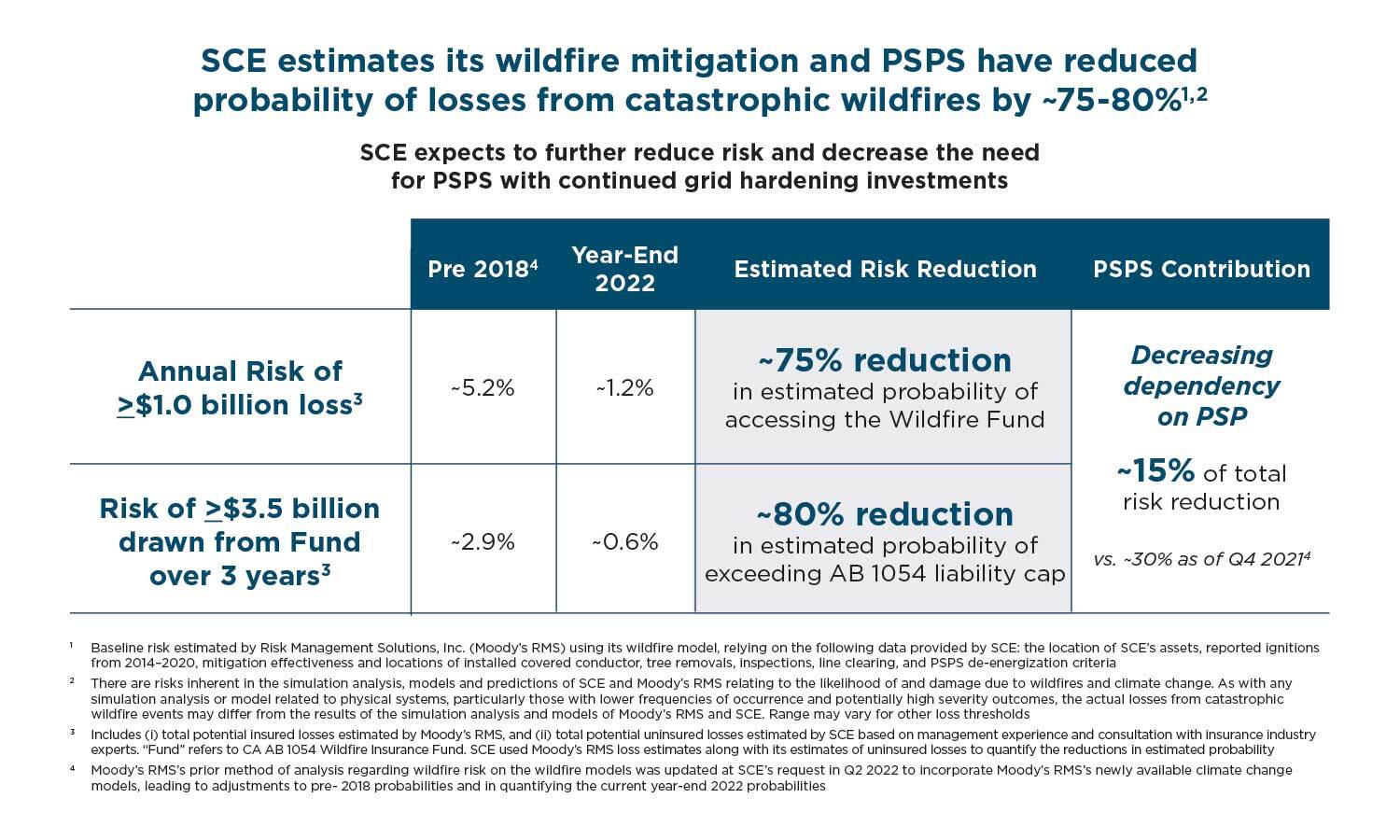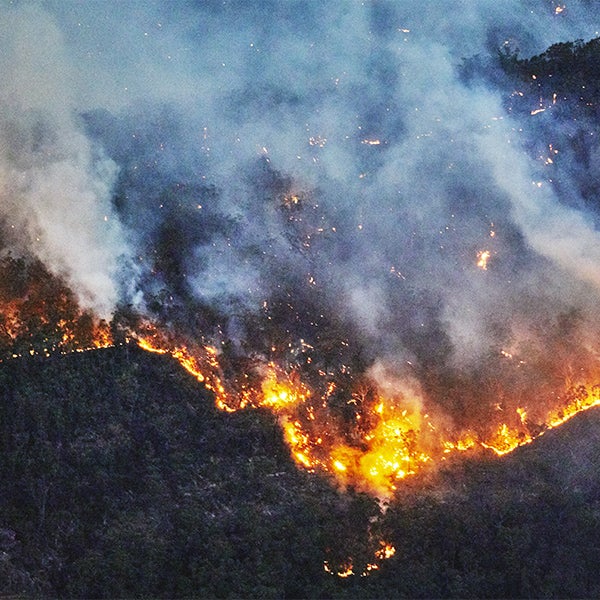The Goal
Measuring Improved Outcomes Around Wildfire Risk
Southern California Edison (SCE) is a retail utility company that handles electrical distribution and transmission serving 15 million people across a region of 50,000+ square miles.
SCE has been making targeted investments in risk mitigation measures both to reduce the chance of wildfires caused by its infrastructure and to refine the use of its proactive public safety power shutoff (PSPS) process to reduce the impact of shutdowns on customers.
SCE needed to update its existing wildfire risk model to include the risk reduction impacts of SCE’s physical mitigation measures as well as the impacts from the use of PSPS.
The Objective
Proving the Value of Mitigations and Improving PSPS
In 2018, following the Woolsey Fire, SCE began refining the PSPS program after recognizing that it needed to be more surgical in its approach and lessen customer hardship. The proactive PSPS mechanism is triggered by certain weather conditions that have the potential to cause significant wildfire spread.
SCE had also been implementing a range of mitigation measures in the highest risk areas of its network to reduce the occurrence of wildfires generated by electricity lines. This included the installation of wires with a protective coating, called covered conductors, and pruning vegetation near lines.
The company needed a method to show to its customers, regulators, and shareholders that the investments were balanced by a measurable reduction in wildfire ignitions from power lines and fewer incidents of PSPS activation.
Effective mitigation measures would also reduce the need for SCE to draw the state-backed risk transfer mechanism, the California Wildfire Fund, for property and liability claims. SCE could potentially bring down the cost of commercial wildfire insurance coverage, which has increased dramatically in recent years.
The Solution
Moody's RMS Risk Modeler and the North America Wildfire HD and Climate Change Model
Risk Modeler™️, part of the Moody's RMS™Intelligent Risk Platform™️, is a highly flexible and cloud-native modeling application that includes the Moody's RMS North America Wildfire HD Model and Climate Change Model. Moody's RMS recommended its wildfire model, in concert with the accompanying industry exposure database, to deliver an initial baseline view of wildfire risks in the region where SCE operates.
The Process
Those baseline assumptions could then be refined to build a dataset that correlated wildfire exposures in the region with the precise location of SCE’s power lines and distribution infrastructure. This would allow Moody's RMS to assess where potential losses were most likely to be triggered and measure the impact of wildfire mitigation, including expedited grid hardening work to reduce the scope and frequency of PSPS.
Collaborating on a Forward- Looking View of Risk
SCE supplied Moody's RMS with data on the location of its distribution infrastructure, down to the level of individual poles; the risk profile of the region of operations, including high fire risk areas where there is abundant vegetation and prevailing weather conditions that are conducive to wildfire ignition; and ignition data reported to its regulator, the California Public Utilities Commission.
SCE also provided the location and scope of mitigation measures that had already been deployed, plus the company’s assessment of their effectiveness. Finally, SCE gave Moody's RMS the details of how the PSPS program works: when it is executed and a variety of thresholds, including weather and fuel conditions, that trigger the process.
Using SCE’s data, Moody's RMS was able to deliver loss analytics that allowed insight into the company’s loss distributions, over a 50,000-year simulation period, from wildfire events potentially ignited by its network. For each year, the Moody's RMS model simulated multiple wildfire events, the total burn area, and loss total associated with the event (including the number of structures damaged or destroyed). Then it determined which of those events could be attributed to SCE’s network.

The Outcome
After generating the initial baseline wildfire model, which showed the loss distribution attributed to SCE with no mitigations in place, Moody's RMS created a methodology that enabled rerunning the analysis to incorporate SCE’s data on the scope and effectiveness of mitigations. Moody's RMS was then able to quantify the difference in risk both before and after mitigation measures were put into place.
Based on SCE data and the Moody's RMS modeling and exposure database, findings estimated that wildfire mitigations had reduced the risk of $1 billion in wildfire losses over one year by 55% and reduced the risk of $3.5 billion in losses over three years by 65%.
Using Moody's RMS analytics, SCE could measure the effectiveness of its risk buydown program while assessing the potential for future wildfire losses, with a view to incorporating the likely impact of climate change on weather conditions.
In modeling the risk profile of all SCE’s overhead lines in high fire risk areas and comparing that to mitigations, Moody's RMS was able to deliver a number of use cases for the modeled data, including:
- Measurable outcome of the effectiveness of current mitigation efforts in reducing incidents of wildfire ignition
- Statistical basis for the net benefit of mitigation investment showing that the cost of mitigations reduces wildfire losses
All SCE stakeholders recognize the importance of wildfire mitigation work, but the Moody's RMS Wildfire HD Model enabled SCE to validate the success of measures for reducing wildfires and quantify the value of the investments the utility has, and will continue to, make. It also provided a basis for the company to identify areas to target expedited grid hardening work to reduce to hardship on customers who face frequent PSPS activations.
The project gave SCE a view of the likely effectiveness of future mitigations taking into account the effects of climate change, and the ability to assess the best mix of mitigation investments to reduce wildfire risk, such as areas where targeted undergrounding could provide benefits over the use of covered conductor.

© 2023 Risk Management Solutions, Inc. and/or its affiliates and licensors (“Moody’s RMS”). All rights reserved. All names, logos, and icons identifying Moody’s RMS and/or its products and services are trademarks of Risk Management Solutions, Inc. and/or its licensors or affiliates. Third-party trademarks referenced herein are the property of their respective owners.
Risk Management Solutions, Inc. is a subsidiary of Moody’s Corporation (NYSE: MCO) and operates as part of the Moody’s Analytics business segment. Moody’s Analytics is operationally and legally separate from the Moody’s Investors Service credit rating agency.

An Edison International (NYSE: EIX) company, Southern California Edison (SCE) is one of the nation’s largest electric utilities and a longtime leader in renewable energy and energy efficiency. SCE serves a population of approximately 15 million via 5 million customer accounts in a 50,000-square-mile service area within Central, Coastal and Southern California. SCE has provided electric service in the region for 135 years.







